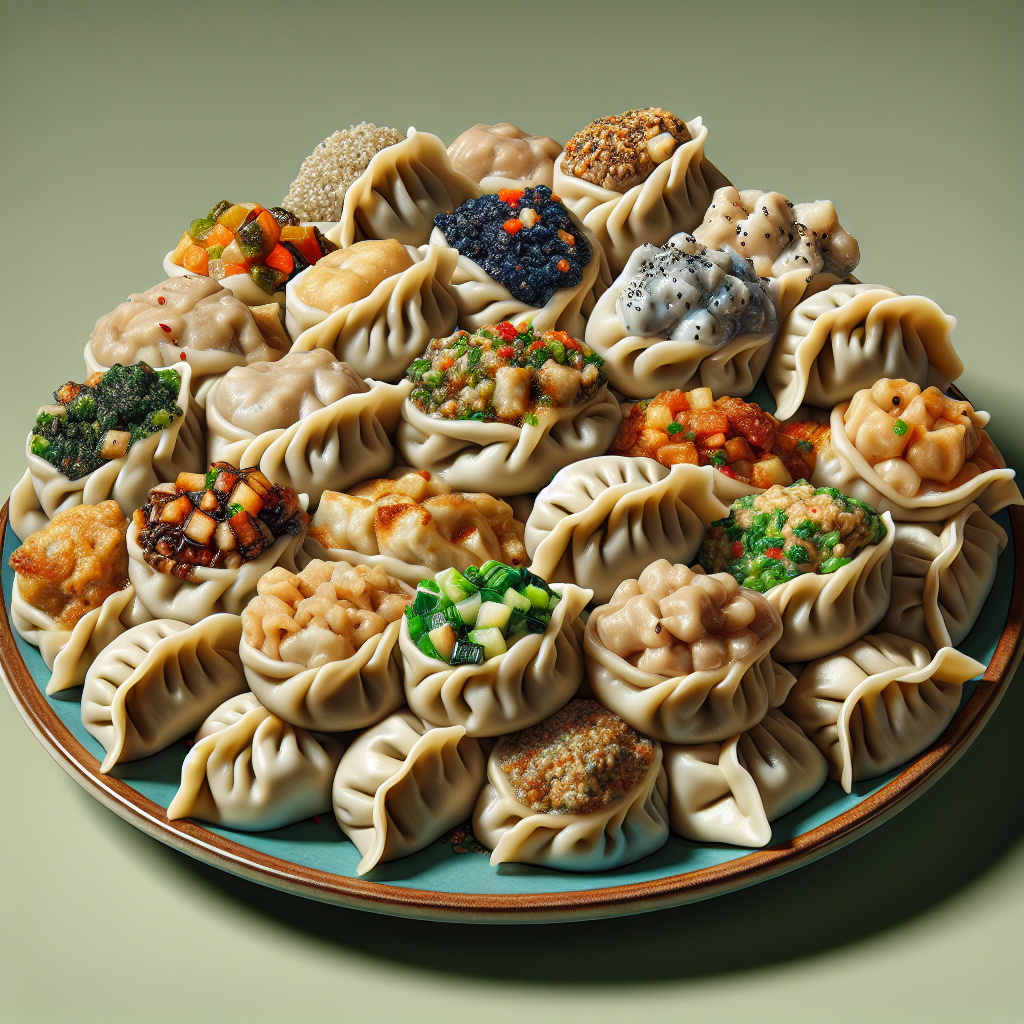Embark on a mouthwatering journey through the vibrant tapestry of Chinese cuisine, as we uncover the flavorful secrets of the nation’s diverse culinary heritage. From the fiery spices of Sichuan to the delicate flavors of Jiangsu, Tastepan.com invites you to savor the eight regional cuisines that have shaped the palates of millions. By delving into the history, traditions, and distinctive ingredients of each region, you’ll gain a deeper understanding of the immense culinary legacy that China proudly embraces. Get ready to tantalize your taste buds and expand your culinary horizons like never before.

The Eight Regional Cuisines of China
An Introduction to China’s Culinary Heritage
China boasts a rich culinary heritage, with each region offering its own unique flavors and cooking styles. From the hearty and flavorful dishes of the North to the light and delicate flavors of the South, Chinese cuisine is a reflection of the country’s diverse culture and geography. In this article, we will explore the eight regional cuisines of China, delving into their origins, characteristics, popular dishes, and notable regional variations. So get ready to embark on a culinary journey through China’s diverse flavors and traditions!
Northern Cuisine: Hearty and Flavorful
Northern cuisine, also known as “Lu Cuisine,” is characterized by its hearty and flavorful dishes. This cuisine is influenced by the colder climate of the region, with dishes often featuring warming ingredients such as lamb, beef, and root vegetables. The flavors in Northern cuisine tend to be bold and savory, with frequent use of soy sauce, vinegar, garlic, and ginger.
Some popular dishes from Northern cuisine include Peking Duck, a roasted duck dish known for its crispy skin and tender meat, and Mongolian Hot Pot, a communal dish where diners cook a variety of ingredients in a simmering broth. The region is also famous for its dumplings, which can be filled with a variety of ingredients such as pork, cabbage, and mushrooms.
Notable regional variations in Northern cuisine include the Shandong and Beijing styles. Shandong cuisine, known for its seafood dishes, utilizes fresh ingredients from the Yellow Sea. Beijing cuisine, on the other hand, is characterized by its imperial dishes and delicate flavors.
Southern Cuisine: Light and Delicate
Southern cuisine, also known as “Yue Cuisine,” is famous for its light and delicate flavors. This cuisine focuses on preserving the natural tastes of the ingredients and uses techniques such as steaming and stir-frying to achieve this. Southern cuisine often incorporates a wide variety of seafood due to its proximity to rivers and the sea.
Popular dishes from Southern cuisine include Cantonese Dim Sum, a style of bite-sized dishes such as dumplings, buns, and rolls, and Sweet and Sour Pork, a popular dish that balances tangy and sweet flavors. Another iconic dish is the Hainanese Chicken Rice, which features tender poached chicken served with fragrant rice cooked in chicken broth.
Southern cuisine exhibits notable regional variations, with distinct styles found in Guangdong, Fujian, and Zhejiang provinces. Guangdong cuisine, also known as Cantonese cuisine, is known for its extensive use of fresh ingredients and dim sum culture. Fujian cuisine incorporates exotic seafood and emphasizes the use of soups, while Zhejiang cuisine focuses on lightness and delicate flavors.
Eastern Cuisine: Fresh Seafood and Mild Flavors
Eastern cuisine, also known as “Lujiang Cuisine,” takes advantage of the region’s abundant access to fresh seafood. The flavors in Eastern cuisine are mild and gentle, allowing the natural flavors of the ingredients to shine. This cuisine often features dishes that are lightly seasoned, lightly stir-fried, or steamed.
Popular dishes from Eastern cuisine include Fish Congee, a comforting rice porridge with seasoned fish, and Sweet and Sour Mandarin Fish, a dish known for its crispy skin and tender flesh. Another notable dish is the Shanghai Soup Dumplings, also known as xiaolongbao, which are steamed dumplings filled with a soupy pork filling.
Notable regional variations within Eastern cuisine can be found in Shanghai, Jiangsu, and Zhejiang provinces. Shanghai cuisine, influenced by its cosmopolitan nature, features a blend of Chinese and Western flavors. Jiangsu cuisine focuses on meticulous preparation and delicate presentation, often using braising techniques. Zhejiang cuisine, also known as Hangzhou cuisine, emphasizes the freshness of ingredients and is known for its variety of soups.
Western Cuisine: Spicy and Savory
Western cuisine, also known as “Xichuan Cuisine,” is characterized by its bold and spicy flavors. This cuisine originates from the Sichuan province, which is known for its fiery dishes. The use of chili peppers, Sichuan peppercorns, and garlic gives Sichuan cuisine its distinctive and mouth-numbing flavor profile.
Popular dishes from Western cuisine include Kung Pao Chicken, a spicy stir-fry dish featuring chicken, peanuts, and chili peppers, and Mapo Tofu, a delicious combination of silky tofu, ground pork, and chili bean paste. The region is also famous for its Hot Pot, where diners cook a variety of ingredients in a bubbling pot of spicy broth.
Notable regional variations within Western cuisine can be found in Sichuan and Chongqing. Sichuan cuisine is known for its bold flavors and its use of numbing spices, while Chongqing cuisine is famous for its hot and spicy dishes.
Central Cuisine: Balance of Flavors
Central cuisine, also known as “Huaiyang Cuisine,” is renowned for its balance of flavors. This cuisine originates from the central part of China and incorporates elements from neighboring cuisines. Central cuisine focuses on preparing high-quality ingredients with meticulous techniques to bring out their natural flavors.
Popular dishes from Central cuisine include Beggar’s Chicken, a whole chicken wrapped with lotus leaves and clay, and Lion’s Head Meatballs, which are large pork meatballs cooked in a savory broth. The region is also known for its variety of freshwater fish dishes, such as the Three Fresh Delicacies Soup.
Notable regional variations within Central cuisine can be found in Jiangsu, Anhui, and Hubei provinces. Jiangsu cuisine, also known as Su cuisine, is characterized by its delicate flavors and meticulous cooking techniques. Anhui cuisine features earthy and rustic flavors, often incorporating wild herbs and mountainous ingredients. Hubei cuisine is known for its use of freshwater fish and wild game.
Northeastern Cuisine: Influenced by Russian and Korean Traditions
Northeastern cuisine, also known as “Dongbei Cuisine,” is heavily influenced by its neighboring countries, Russia and Korea. The flavors in this cuisine are bold, hearty, and often incorporate pickled ingredients. Due to the cold climate, Northeastern cuisine features filling dishes with a focus on preserving food for the long winter months.
Popular dishes from Northeastern cuisine include Dongbei Cabbage and Pork Dumplings, a savory dumpling filled with cabbage and pork, and Guo Bao Rou, a sweet and sour pork dish with a rich caramelized glaze. The region is also known for its use of preserved ingredients, such as pickled vegetables and cured meats.
Notable regional variations within Northeastern cuisine can be found in Liaoning, Jilin, and Heilongjiang provinces. Liaoning cuisine features a blend of Chinese, Russian, and Korean influences, and is known for its hearty and filling dishes. Jilin cuisine specializes in hot and spicy flavors, incorporating fermented ingredients. Heilongjiang cuisine emphasizes fresh and wild ingredients, often incorporating game meat and river fish.
Northwestern Cuisine: Influence of Islamic and Mongolian Culinary Traditions
Northwestern cuisine, also known as “Xibei Cuisine,” is influenced by Islamic and Mongolian culinary traditions. This cuisine incorporates flavors from the Silk Road and features dishes that are hearty, rich, and robust. The Northwestern region is known for its use of lamb, beef, wheat, and dairy products.
Popular dishes from Northwestern cuisine include Xinjiang Lamb Skewers, tender pieces of marinated lamb grilled to perfection, and Lanzhou Beef Noodles, a fragrant soup with hand-pulled noodles and succulent beef. The region is also known for its pilaf-style rice dishes, which often include dried fruits, nuts, and aromatic spices.
Notable regional variations within Northwestern cuisine can be found in Xinjiang, Ningxia, and Gansu provinces. Xinjiang cuisine combines flavors from Central Asia, the Middle East, and China, resulting in unique dishes with a blend of spices and textures. Ningxia cuisine features Northwestern flavors with Islamic influences, often incorporating lamb and wheat. Gansu cuisine incorporates both Islamic and Chinese flavors, and is known for its nourishing and hearty dishes.
Southwestern Cuisine: Spicy and Bold
Southwestern cuisine, also known as “Chuan Cuisine,” is characterized by its bold and spicy flavors. This cuisine originates from the Sichuan and Chongqing regions and is known for its use of chili peppers and Sichuan peppercorns. Southwestern cuisine is famous for its numbing and spicy sensation, often referred to as “ma la.”
Popular dishes from Southwestern cuisine include Mapo Tofu, a spicy dish with tofu and minced meat, and Sichuan Hot Pot, a communal dish where diners cook a variety of ingredients in a spicy broth. The region is also famous for its use of pickled vegetables, fermented beans, and strong aromatic spices.
Notable regional variations within Southwestern cuisine can be found in Sichuan and Chongqing. Sichuan cuisine, as mentioned earlier, is known for its bold and spicy flavors. Chongqing cuisine, on the other hand, focuses on hot and numbing flavors, often incorporating Sichuan peppercorns and dried chili peppers.
Southeastern Cuisine: Fusion of Multiple Regional Flavors
Southeastern cuisine, also known as “Min Cuisine,” is a fusion of multiple regional flavors from neighboring provinces such as Fujian, Zhejiang, and Jiangsu. This cuisine exhibits a balance of sweet, sour, and salty flavors, with emphasis on seafood and fresh ingredients.
Popular dishes from Southeastern cuisine include Sweet and Sour Pork Ribs, a succulent pork rib dish with a tangy glaze, and Buddha Jumps Over the Wall, a rich soup with a variety of ingredients such as seafood, poultry, and mushrooms. The region is also famous for its seafood delicacies and delicate soups.
Notable regional variations within Southeastern cuisine can be found in Fujian, Zhejiang, and Jiangsu provinces. Fujian cuisine incorporates a variety of seafood and focuses on soups and stews. Zhejiang cuisine emphasizes the natural flavors of ingredients and is known for its use of techniques such as quick-frying and stir-frying. Jiangsu cuisine, as mentioned earlier, focuses on meticulous preparation and delicate presentation.

An Introduction to China’s Culinary Heritage
Chinese cuisine holds remarkable historical significance and reflects the country’s rich culture and traditions. It is deeply intertwined with ancient philosophy and traditional medicine, and is driven by the beliefs of harmony, balance, and the pursuit of a healthy lifestyle.
Ancient Chinese philosophy, particularly Daoism and Confucianism, has played a significant role in shaping Chinese cuisine. These philosophies emphasize the concept of balance, which is reflected in the selection of ingredients, the combination of flavors, and the cooking techniques used. The yin-yang theory, the Five Elements theory, and the Qi theory all contribute to the harmonious and balanced nature of Chinese cuisine.
Traditional Chinese medicine also heavily influences Chinese culinary practices. Food is seen as a source of nourishment and healing, and ingredients are chosen for their nutritional value and health benefits. Dishes are often prepared with specific ingredients to address various health conditions, aiming to restore balance and harmony within the body.
Symbolism and rituals also play an integral role in Chinese dining culture. Many traditional Chinese dishes are prepared and served during auspicious occasions and festivals, symbolizing good luck, wealth, and happiness. In addition, the act of sharing a meal with family and friends is considered a bonding experience and an expression of love and respect.
Chinese culinary techniques are diverse and encompass a wide range of skills. From stir-frying and deep-frying to steaming and braising, each technique is suited to different ingredients and is carefully executed to maximize flavor and texture. Chinese chefs are highly skilled in knife work and precise cutting techniques, which contribute to the aesthetic appeal of the dishes.
The ingredients used in Chinese cuisine are varied and reflect the diverse geography and climate of the country. From the fertile plains of the South to the cold and arid landscapes of the North, each region offers its own unique ingredients and flavors. Common ingredients include rice, wheat, vegetables, soybeans, tofu, seafood, poultry, and a wide array of herbs and spices.
In conclusion, Chinese cuisine is a treasure trove of flavors, techniques, and cultural symbolism. The eight regional cuisines of China showcase the immense diversity and richness of the country’s culinary heritage. Whether you prefer the bold spices of Sichuan or the delicate flavors of Cantonese cuisine, exploring the regional cuisines of China is an adventure that will delight your taste buds and deepen your appreciation for the global tapestry of flavors.


